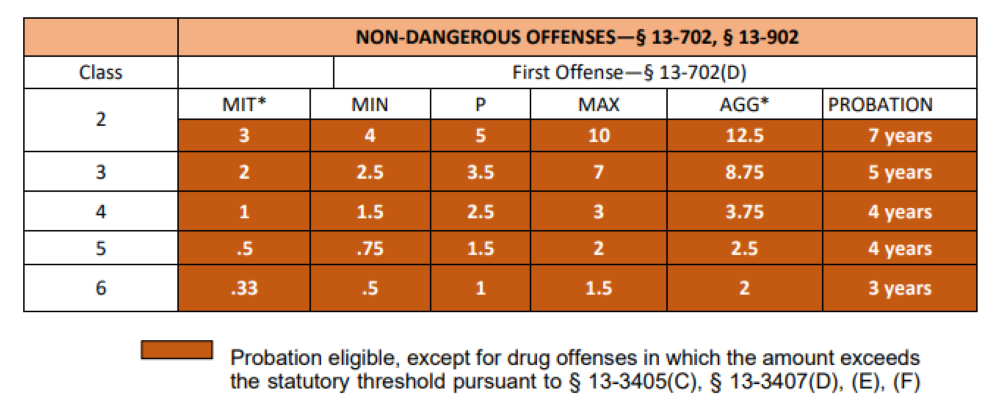Sentencing Lengths for Arizona Felonies
Felony crimes in Arizona follow a sentencing chart that sets incarceration ranges based on different factors. The Arizona Supreme Court provides the charts for the criminal code sentencing provisions here.
Sentencing provisions vary based on many factors such as whether the offense was dangerous or non-dangerous, committed by a first-time or a repeat offender, and whether or not there were aggravating or mitigating circumstances.
Mitigating factors, such as mental health issues, remorse, and positive character statements are those which allow a defendant’s sentence to be lessened. Aggravating factors, such as criminal history or especially heinous crimes, are those which may cause a defendant’s sentence to be lengthened.
For a basic understanding of sentence ranges, we can look at the chart below for non-dangerous crimes committed by first-time offenders.


This chart lists the felony class (2 through 6) as well as the length in years of incarceration time by type of sentence. These are mitigated (MIT*), minimum (MIN), presumptive (P), maximum (MAX), and aggravated (AGG).
For an individual convicted of a class 3 felony, they would have a mitigated sentence of 2 years, a minimum sentence of 2.5 years, a presumptive sentence of 3.5 years, a maximum sentence of 7 years, and an aggravated sentence of 8.75 years.
In this case, a defendant who lacks any mitigating or aggravating factors would be sentenced to the presumptive sentence of 3.5 years. Presumptive sentences are considered standard and normal.
If there are mitigating factors present, the court can weigh these and choose to impose the mitigated sentence of 2 years or the minimum sentence of 2.5 years.
If there is even one aggravating factor present, the court can choose to impose the aggravated sentence of 8.75 years. The court will also choose to impose the aggravated sentence if an aggravating factor is present without a mitigating factor. The court can also choose to impose the maximum sentence of 7 years.
When both mitigating and aggravating factors are present, the court will consider the merit and relevancy of each side in order to impose a sentence.
Dangerous offenses do not offer mitigated or aggravated sentences. Instead, a court can only impose minimum, presumptive, or maximum sentences.
Aggravating factors that can cause a sentence to be more severe will be presented in court by the prosecutor. For this reason, it is vital to have an experienced defense attorney who can gather all the mitigating factors needed to be weighed against the prosecution. Additionally, if no aggravating factors are present, presenting solid mitigating factors can help to greatly lessen the final sentence imposed.
RIDEOUT LAW GROUP
With offices in Lake Havasu City and Scottsdale, our firm serves the entire state of Arizona, with a particular focus on criminal defense, family law, and juvenile cases.
Our goal is for the best outcome for your criminal case, which can include:
- charges that are reduced or dropped.
- top experts reviewing your case.
- aggressive negotiations with the prosecution for plea bargains.
- fines or probation in lieu of jail time.
At Rideout Law Group, our attorneys are able to expertly examine the evidence in your case to provide a strong strategy for argument that leads to an outcome that is most favorable to you. We have experience in all types of criminal cases for both adults and juveniles, with positive outcomes both in plea negotiations as well as jury trial settings.
Call us today for a free consultation at 480-584-3328.
